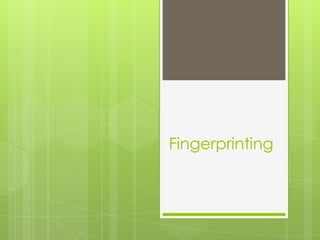
Fingerprinting
- 2. Historical Development 1. The oldest known documents showing fingerprints date from third century B.C. China. 2. In ancient Babylon (dating back to 1792-1750 B.C.), fingerprints pressed into clay tablets marked contracts. 3. The earliest written study (1684) is Dr. Nehemiah’s paper describing the patterns he saw on human hands under a microscope, including the presence of ridges. 4. In 1788, Johann Mayer noted that the arrangement of skin ridges is never duplicated in two persons. He was probably the first scientist to recognize this fact.
- 3. Historical Development 5. Nine fingerprint patterns were described in 1823 by Jan Evangelist Purkyn. 6. Sir William Herschel (shown at the right), in 1856, began the collection of fingerprints and noted they were not altered by age. 7. Alphonse Bertillon created a way to identify criminals that was used in 1883 to identify a repeat offender. 8. In 1888, Sir Francis Galton (shown at the right), and Sir Edmund Richard Henry, developed the fingerprint classification system that is still in use in the United States.
- 4. Historical Development 9. In 1891, Iván (Juan) Vucetich improved fingerprint collection. He began to note measurements on identification cards, as well as adding all ten fingerprint impressions. He also invented a better way of collecting the impressions. 10. Beginning in 1896, Sir Henry (mentioned in the last entry on the previous slide), with the help of two colleagues, created a system that divided fingerprints into groups. Along with notations about individual characteristics, all ten fingerprints were imprinted on a card (called a ten card).
- 5. What are Fingerprints? All fingers, toes, feet, and palms are covered in small ridges. These ridges are arranged in connected units called dermal, or friction, ridges. These ridges help us get or keep our grip on objects. Natural secretions plus dirt on these surfaces leave behind an impression (a print) on those objects with which we come in contact.
- 6. Formation of Fingerprints An animal’s external tissue (skin) consists of (a) an inner dermis and (b) an outer epidermis. The creation of fingerprints occurs in a special layer (the basal layer) in the epidermis where new skin cells are produced. Fingerprints probably begin forming at the start of the 10th week of pregnancy. Because the basal layer grows faster than the others, it collapses, forming intricate shapes.
- 7. General Classification There are 3 general fingerprint distinctions: ARCH WHORL LOOP About 5% About 30% About 65% of the population
- 8. What to look for: Forensic examiners look for the presence of a core (the center of a whorl or loop) and deltas (triangular regions near a loop). A ridge count is another characteristic that distinguishes one fingerprint from another. The count is made from the center of the core to the edge of the delta.
- 10. Types of Prints There are 3 types of prints that investigators look for at crime scenes: 1. Patent fingerprints are visible prints transferred onto smooth surfaces by blood or other liquids. 2. Plastic fingerprints are indentations left in soft materials such as clay or wax. 3. Latent fingerprints are not visible but made so by dusting with powders or the use of chemicals.
- 11. FAQs Can fingerprints be erased? No, if, for example, they are removed with chemicals, they will grow back. Is fingerprint identification reliable? Yes, but analysts can make mistakes. Is fingerprint matching carried out by computers in a matter of seconds? No, but the FBI’s Integrated Automated Fingerprint Identification System (IAFIS or AFIS) can provide a match in 2 hours for the prints in its Master File.
- 12. The Future New scanning technologies and digitally identifying patterns may eliminate analytical mistakes. Trace elements of objects that have been touched are being studied to help with the identification of individuals. To help with identification, other physical features such as eyes and facial patterns are also being studied. - Biometrics